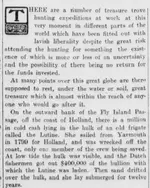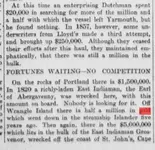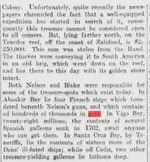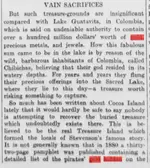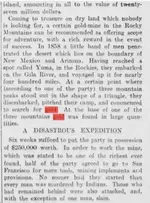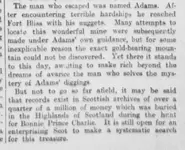A bit of history does not look like there was gold onboard...
The reef which HMS Tenedos struck, while looking for suitable landing places on the coast, was unknown at the time, and the ships of the “Cape of Good Hope and West Coast of Africa” squadron were working outside of their assigned area during the Zulu War. Charts used during that time did not record the reef on which “Tenedos” struck. It might also be noted that there was no censure of Captain Adeane for the incident. "Tenedos" and "Active" were both men-of-war and were not designed for coastal exploration, but they were all that were available at the time. Afterwards, Commodore Sullivan had HMS Forrester moved from the West Coast of Africa to take over the duties of coastal exploration, and to find a landing place on the coast.
I hope this answers your question. Below are three contemporaneous reports on the incident.
Letter from Governor Frere
"Her Majesty's Government will have heard with regret of the grounding of H.M. ships " Active" and "Tenedos" on a shoal previously unknown and unmarked, when examining the Zulu coast. The temporary disabling of H.M. ship "Tenedos " will be a serious loss to us, as the aid given by Captain Adeane and his crew promised to be as effectual as that we have already repeatedly received throughout the late and present war, from Commodore Sullivan and the " Active," which carries his pennant." (From: Accounts and Papers of the House of Commons, c.2252 Further Correspondence respecting the Affairs of South Africa)
Message Commodore Sullivan, Durban, to Senior Naval Officer, Simon's Town.
"Inform Admiralty, by telegraph via Madeira, "Active" and "Tenedos" both got ashore during late cruise on Zulu coast. "Active" merely grazed and is unhurt. "Tenedos," on shore 16 hours on reef of rocks hitherto unknown, has sustained severe damage; main keel nearly all gone, and screw disabled. Will probably have to send her to England, as, being hurricane season, do not consider it safe to send her to Mauritius." (From: Accounts and Papers of the House of Commons, c.2454 Further Correspondence respecting the Affairs of South Africa)
Article in Royal Geographical Society Report
"The war in Zulu-Land has called attention to the unsurveyed state of parts of the coasts of South Africa, for although the coast-line is correctly delineated, yet the absence of soundings renders the approach very dangerous. In the early part of the year, H.M.S. Active and Tenedos were in great danger, through having grounded on some unknown reefs between the Tugela River and Point Durnford. It is to be hoped that the Admiralty, after this warning, may be induced to send out a properly equipped surveying vessel to execute sorely needed work, both on the east and west coasts of Africa (northwards from Bashee River on one side, and St. Helena Bay on the other), which have not been sounded since the days of Captain Owen, half a century ago." (From: Proceedings of the Royal Geographical Society and Monthly Record of Geography, 1879, p. 366)
HMS Tenedos grounded on the reef on 17 January, and was stuck there for 16 hours. She was finally pulled free by HMS Active, and in the process collided with “Active” causing minor damage to that ship. “Tenedos” had severe damage to its keel and its screw was disabled. She was towed back to Durban by “Active”, and then sent to Simons Bay for some repairs. Simon’s Bay did not have the necessary facilities so “Tenedos” was then ordered back to England. The naval brigade of “Tenedos” was recalled to join the ship. They arrived in Durban on 7 May and departed for Simons Bay on 8 May aboard the hired transport “Andean.” On the 15 June “Tenedos” took part in the ceremonies at Simons Bay for the transfer of the Prince Imperial’s body from HMS Boadicea to HMS Orontes. On 21 June “Tenedos” departed Simons Bay for England. After the repairs to “Tenedos” were completed in England, the ship was assigned to the North America and West Indies Squadron.
Captain Adeane’s career does not seem to have been affected by the incident. He was awarded Companion of St. Michael and St. George in December 1879 for services in the Zulu War. He was promoted to Rear Admiral in 1888, Vice Admiral in 1893 and Admiral in 1898 before retiring in 1901.
The reason “Tenedos” was in that particular area when she struck the reef is that the Navy was tasked with finding a landing place on the coast where supplies and reinforcements could be landed to support the land forces, thus avoiding having to transport them by land. The area known as Port Durnford was finally chosen as the only suitable place on the coast where this could be accomplished.
"A Court-Martial has been held on Captain Pollard of the H.M.S Tenedos, who was charged with endangering his vessel off the coast of South Africa, which resulted in his being dismissed from his ship."
HMS Active had already landed a Naval Brigade of about 130 sailors and 42 marines in November 1878 as part of Colonel Pearson’s Number One column. HMS Tenedos landed 46 sailors and 15 marines on 1 January 1879, who were stationed at Fort Pearson, and later at Fort Tenedos. This left both ships undermanned, and it is unlikely they would have supplied any substantial number of additional men. The ships were only scouting for a landing place for supplies to support the initial plan of the different columns merging on Ulundi. There was no one else left that that these ships could have landed that would have had any effect on the events of the 22nd January. All available Imperial and Colonial forces were already in the field or manning the lines of communications.
After 22 January 1879 Lord Chelmsford’s moved number 2 and 3 columns back across the river into Natal. Number 1 Column was forced to fortify Eshowe and was stuck there for about 10 weeks. After the reinforcements from England started arriving the landing site at Port Durnford was intended for supplies and troops. Part of the troop buildup included a battalion of marines from England, and other reinforcements that Sir Garnet Wolseley intended to land at Port Durnford to push inland. Wolseley had been sent to South Africa to take command of the forces there. On 30 June about 18 tons of supplies were landed at Port Durnford, and on 1 July another 60 tons. Lord Chelmsford pushed on to Ulundi without the support of the Coastal Column, and after his victory there on 4 July, Wolseley ordered the Marine Battalion halted at Simon’s Bay, when after two weeks they returned to England. Wolseley also released the members of the Naval Brigade so that they could return to their ships. By 27 July they had all withdrawn.

